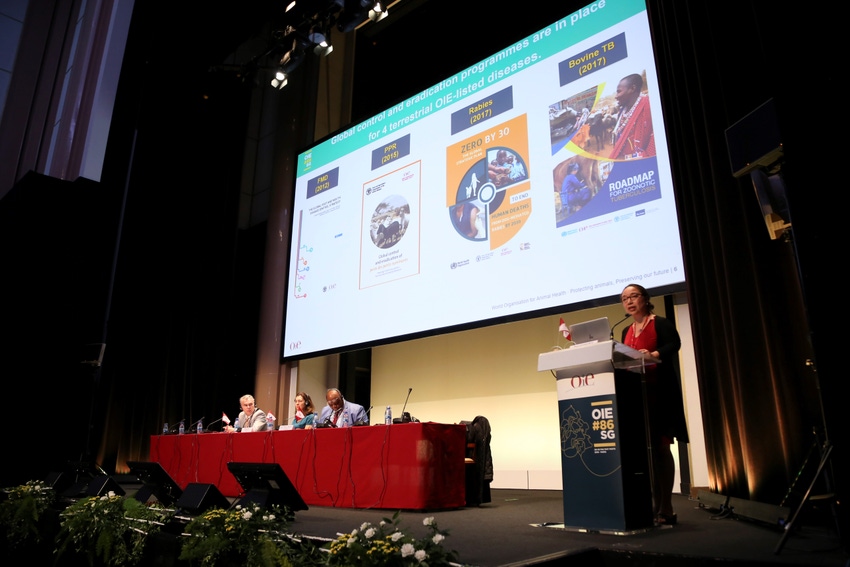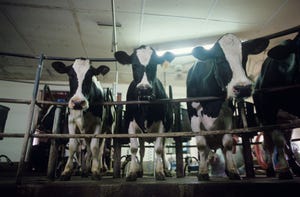OIE adopts antimicrobial definitions
Definitions differentiate veterinary medical use and non-veterinary medical use, with latter including growth promotion.
May 25, 2018

At the occasion of the 86th General Session of the World Organization for Animal Health (OIE) held May 20-25 in Paris, France, the OIE member countries discussed several revisions to OIE international standards and guidelines, resulting in stronger veterinary supervision of the use of antimicrobials in animals worldwide.
OIE and its 181 member countries have built over 10 years a comprehensive set of international standards and guidelines, providing a framework for responsible and prudent use of antimicrobial products in animals and for the surveillance and monitoring of antimicrobial resistance and the quantities of antimicrobials used.
OIE said the discussion during the general session resulted in three main updates and adaptations to these standards.
First, to fight the expected rise of antimicrobial resistance, bringing the use of antimicrobials in humans and animals under the supervision of suitably trained medical and veterinary professionals is considered a priority by the international community, notably by the Tripartite — OIE, the U.N. Food & Agriculture Organization (FAO) and the World Health Organization (WHO).
By adopting a new set of definitions to provide a clear framework for data collection on antimicrobial usage, the OIE member countries made a further significant step towards strengthening veterinary supervision of antimicrobial use in terrestrial animals, OIE said.
These definitions differentiate veterinary medical use and non-veterinary medical use, the latter including growth promotion. According to the new version of OIE international standards adopted, chapter Article 6.8.1.-bis of the Terrestrial Code (soon available on www.oie.int/amrstandards), veterinary medical use means the administration of an antimicrobial agent to an individual or a group of animals to treat, control or prevent infectious disease.
OIE said the terms "treat," "control" and "prevent" were also clearly defined:
* To treat means to administer an antimicrobial agent to an individual or a group of animals showing clinical signs of an infectious disease;
* To control means to administer an antimicrobial agent to a group of animals containing sick animals and healthy animals (presumed to be infected), to minimize or resolve clinical signs and to prevent further spread of the disease, and
* To prevent means to administer an antimicrobial agent to an individual or a group of animals at risk of acquiring a specific infection or in a specific situation where infectious disease is likely to occur if the drug is not administered.
On the other side, OIE said non-veterinary medical use means the administration of antimicrobial agents to animals for any purpose other than to treat, control or prevent infectious disease; it includes growth promotion — defined as the administration of antimicrobial agents to animals only to increase the rate of weight gain or the efficiency of feed utilization.
Associated with the already existing OIE international standards on responsible and prudent use of antimicrobial agents in animals, OIE said these new texts adopted will be a "powerful asset" for national veterinary services to advocate for adaptation of national legislation and the reinforcement of veterinary supervision of the use of antimicrobials in animals.
Another topic considered as a priority by the Tripartite is phasing out the use of the most precious antimicrobials for human health as growth promoters in livestock agricultural systems. In 2017, 60 OIE member countries were still reporting use of antimicrobials for growth promotion, either with direct authorization of some compounds or because the country had no regulatory framework on this issue.
Through the adoption of a revised "OIE List of Antimicrobial Agents of Veterinary Importance" (soon available on www.oie.int/amrstandards), the OIE guidelines now state that the responsible and prudent use of antimicrobial agents does not include the use of antimicrobial agents for growth promotion in the absence of risk analysis, OIE said. The classes of antimicrobial agents included in the WHO category of "Highest Priority Critically Important Antimicrobials" for human medicine are also highlighted as being the highest priorities for countries in phasing out use of antimicrobial agents as growth promotors. Finally, the OIE list states that the use of fluoroquinolones, colistin and third and fourth generations of cephalosporins as growth promotors should be urgently prohibited, OIE said.
Finally, revisions to the OIE international standards on the harmonization of national antimicrobial resistance surveillance and monitoring programs were confirmed as adopted on May 25. Recognizing that surveillance for antimicrobial resistance is a significant technical challenge for member countries, these revisions provide detailed scientific guidance for their surveillance national systems.
Discussions will continue to plan the next steps of the fight and support countries in their implementation of OIE international standards, notably at the second OIE Global Conference on Antimicrobial Resistance, to be held Oct. 29-30 in Marrakech, Maroc, as well as through permanent partnership with FAO and WHO within the Tripartite Collaboration.
You May Also Like



